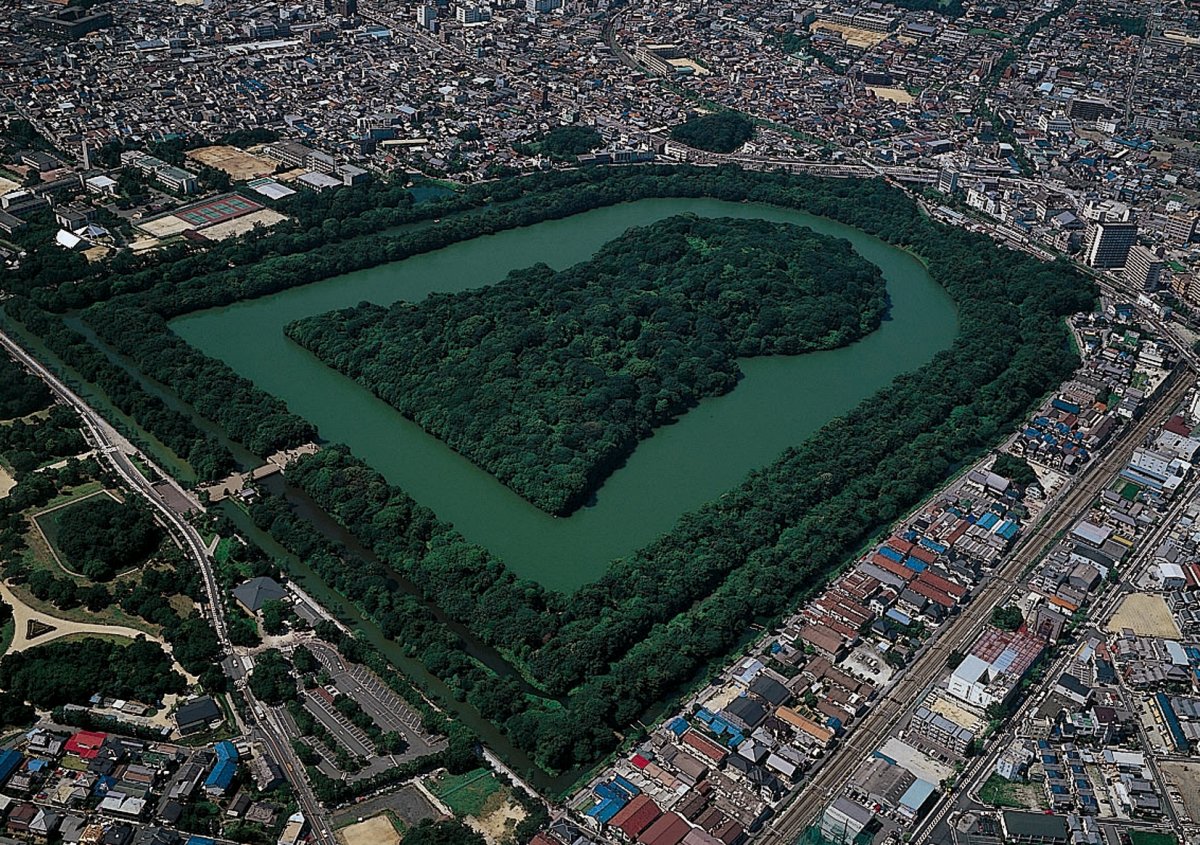MessageToEagle.com – The largest keyhole-shaped tomb in Japan – Daisenryo Kofun – is located in the city of Sakai in Osaka Prefecture, Japan.
Kofun (“ancient grave”) are megalithic tombs or tumuli in Japan, constructed between the early 3rd century and the early 7th century AD. The kofun ancient graves (from Kofun period ca 300-710 AD) have been built in various shapes throughout history.
These structures can be circular- and square-shaped and their dimensions also vary from several meters to over 400m.

The most common type of kofun is shaped like a keyhole (a zempo-koen-fun), having one square end and one circular end, when viewed from above.
The Daisen Kofun in Osaka Prefecture, which belongs to Japan’s Emperor Nintoku, the 16th emperor, measures about 500 meters (1,640 feet) in length, 249 meters in diameter, 35 meters in height for the back circular mound, 305 meters in width and 33 meters in height for the front mound. The mound is built with three distinct levels and with a space for religious ceremonies, on either side of the narrowest part of the tomb, and surrounded by three trenches.
See also:
Sohei And Yamabushi: Fearsome Ancient Warrior Monks Of Japan
Shinobi No Mono: The Shadow Warriors And Hattori ‘The Demon’ Hanzo Of Ancient Japan
Mystery Of The Kusanagi Treasure: The Legendary Sword
There is an about 2.8 kilometer-long walkway encircling the tomb, which takes an hour to walk around.
This huge tomb is located in the middle of a cluster known as the Mozu Tumuli, which consists of 92 large and small kofun lying within an area of roughly 16 square kilometers (6.2 square miles).
Another group of mounds, located about 10 kilometers (6.2 mi) away from the Mozu cluster is known as the Furuichi cluster. It has the Ojin-tenno-ryo Kofun of 425 meters (1,394 ft) length which is said to be the second largest in the country. This group also has 11 more huge massive rounded “keyhole-shaped kofun” with mound length of 200 meters (660 ft) or more.
Thousands kofun burial mounds have been discovered and identified; these date back from the late third to late seventh centuries.
In Japan, there was a common ancient custom to bury people of high social status in kofun tombs that were covered with large mounds of earth.
The kofun funerary mounds were not only used to bury people but also items made of iron, swords, weapons such as arrowheads, hoe and spade tips, fine armor, glass pots, dishes, and many other similar items.
Antiquities made of gilded bronze such as horse tacks and sash buckles have also been found in these mounds.
Keyhole-shaped kofun graves disappeared in the late 6th century AD, and are related to the introduction of Buddhism during this era, according to “The Chronicles of Japan” (“Nihon Shoki”), Japan’s first national history book.
Recently, archaeologists began to doubt whether this enormous tomb really belongs to the Emperor Nintoku.
They have namely, found in the toms, the so-called Sue ware pots, represent making techniques and kilns, which were introduced to Japan from Korea, in the 5th century and these pots were the first high temperature stoneware pots produced in ancient Japan.
Copyright © MessageToEagle.com All rights reserved. This material may not be published, broadcast, rewritten or redistributed in whole or part without the express written permission of MessageToEagle.com
Expand for references





